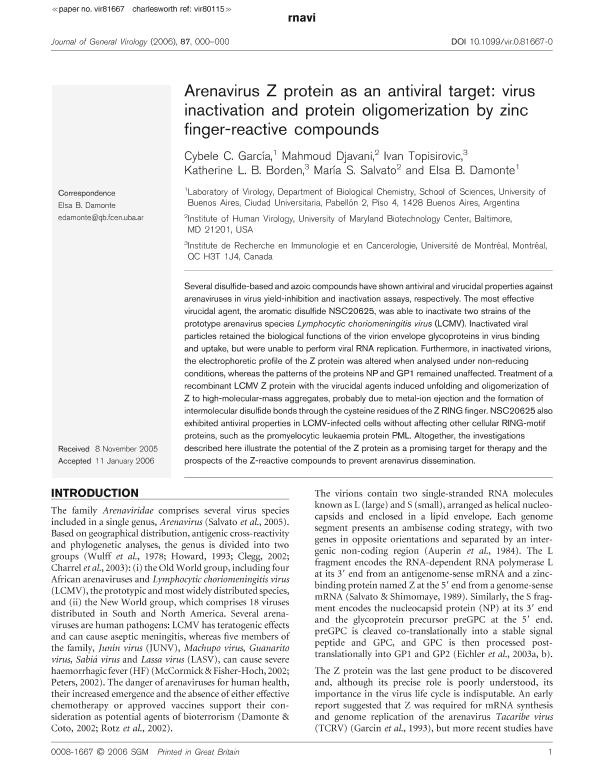Artículo
Arenavirus Z protein as an antiviral target: virus inactivation and protein oligomerization by zinc finger-reactive compounds
Garcia, Cybele ; Djavani, Mahmoud; Topisirovic, Ivan; Borden, Katherine L. B.; Salvato, María S.; Damonte, Elsa Beatriz
; Djavani, Mahmoud; Topisirovic, Ivan; Borden, Katherine L. B.; Salvato, María S.; Damonte, Elsa Beatriz
 ; Djavani, Mahmoud; Topisirovic, Ivan; Borden, Katherine L. B.; Salvato, María S.; Damonte, Elsa Beatriz
; Djavani, Mahmoud; Topisirovic, Ivan; Borden, Katherine L. B.; Salvato, María S.; Damonte, Elsa Beatriz
Fecha de publicación:
05/2006
Editorial:
Society for General Microbiology
Revista:
Journal of General Virology
ISSN:
0022-1317
Idioma:
Inglés
Tipo de recurso:
Artículo publicado
Clasificación temática:
Resumen
Several disulfide-based and azoic compounds have shown antiviral and virucidal properties against arenaviruses in virus yield-inhibition and inactivation assays, respectively. The most effective virucidal agent, the aromatic disulfide NSC20625, was able to inactivate two strains of the prototype arenavirus species Lymphocytic choriomeningitis virus (LCMV). Inactivated viral particles retained the biological functions of the virion envelope glycoproteins in virus binding and uptake, but were unable to perform viral RNA replication. Furthermore, in inactivated virions, the electrophoretic profile of the Z protein was altered when analysed under non-reducing conditions, whereas the patterns of the proteins NP and GP1 remained unaffected. Treatment of a recombinant LCMV Z protein with the virucidal agents induced unfolding and oligomerization of Z to high-molecular-mass aggregates, probably due to metal-ion ejection and the formation of intermolecular disulfide bonds through the cysteine residues of the Z RING finger. NSC20625 also exhibited antiviral properties in LCMV-infected cells without affecting other cellular RING-motif proteins, such as the promyelocytic leukaemia protein PML. Altogether, the investigations described here illustrate the potential of the Z protein as a promising target for therapy and the prospects of the Z-reactive compounds to prevent arenavirus dissemination.
Palabras clave:
antiviral
,
arenavirus
,
inactivation
,
Z protein
Archivos asociados
Licencia
Identificadores
Colecciones
Articulos(IQUIBICEN)
Articulos de INSTITUTO DE QUIMICA BIOLOGICA DE LA FACULTAD DE CS. EXACTAS Y NATURALES
Articulos de INSTITUTO DE QUIMICA BIOLOGICA DE LA FACULTAD DE CS. EXACTAS Y NATURALES
Citación
Garcia, Cybele; Djavani, Mahmoud; Topisirovic, Ivan; Borden, Katherine L. B.; Salvato, María S.; et al.; Arenavirus Z protein as an antiviral target: virus inactivation and protein oligomerization by zinc finger-reactive compounds; Society for General Microbiology; Journal of General Virology; 87; 5; 5-2006; 1217-1228
Compartir
Altmétricas



